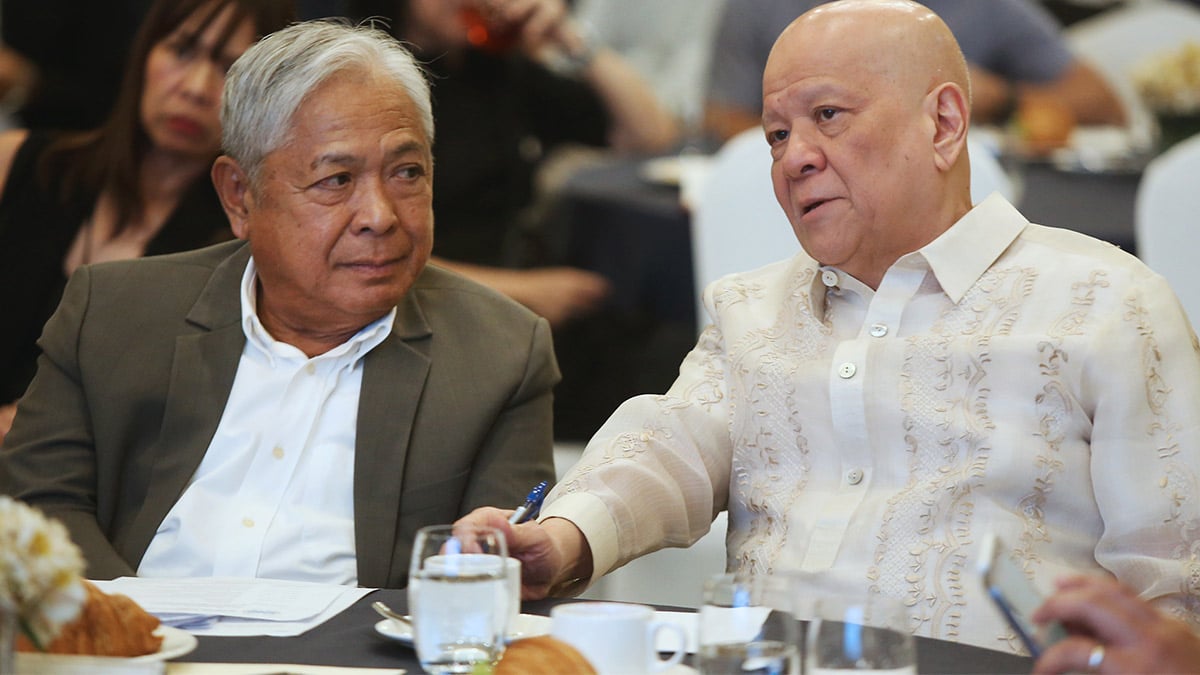
FILE PHOTO: Department of Transportation (DOTr) Secretary Jaime Bautista (left) discusses with San Miguel Corp. chair Ramon Ang the forthcoming improvements at Ninoy Aquino International Airport (Naia) during the forum hosted by the Economic Journalists Association of the Philippines. —EUGENE ARANETA
The Department of Transportation (DOTr) said it expects airline passenger volume to still grow despite the airport fee hikes at the Ninoy Aquino International Airport (Naia).
Naia is currently undergoing a major facelift. The DOTr believes travelers wouldn’t mind paying more for a better experience.
On the sidelines of Aviation Summit 2024 in Pasay on Wednesday, DOTr Secretary Jaime Bautista said the passenger fee increase would be readily absorbed by the travelers.
“For a small amount of increase in the cost, I think it will not affect the tourist arrival,” he said.
The passenger service charge will go up next year, in line with the administrative order issued by the Manila International Airport Authority. This will be implemented by New Naia Infrastructure Corp. (NNIC), the group that took over the gateway’s operations and maintenance.
The passenger service charge will increase from P550 to P990 for international departing passengers and from P200 to P390 for domestic departing passengers.
The fees will be adjusted again in the sixth and 11th year of the 15-year concession period. If it is extended by another 10 years, adjustments on the fees will be done again on the 16th and 21st year.
Bautista stressed that the collected fees would be used to improve the facilities at Naia.
“Passengers won’t mind paying a little bit more than what they are paying now if you have very good airport experience,” he said.
“There are more than 50 million passengers that pass through this airport. And the passengers will continue to travel,” Bautista added.
By 2030, Naia is projected to handle 90 million passengers annually.
Apart from passenger service charge, the airlines’ landing and takeoff fees almost doubled following the issuance of a new matrix effective Oct. 1, Bautista said.
The landing and takeoff fees for international flights during the first year of NNIC’s takeover would cost $794 for an aircraft weighing up to 50,000 kilograms (kg). These would eventually increase at least $952.80 during year five; $1,048.08, year 10; $1,152.89, year 15; and $1,268.18, year 20.
For local flights, airlines will pay P15,417 for aircraft weighing up to 50,000 kg. This will go up to P18,500.40 during year five of NNIC’s takeover; P20,350.44, year 10; P22,385.48, year 15; and P24,624.03, year 20.
“The reason for this is for us to be able to generate revenue, especially the concessionaire, for them to be able to finance the infrastructure requirements to modernize the airport,” the DOTr chief reiterated.
The Naia rehab project costs P170.6 billion, which comprises not only capital expenditures for airport upgrade but also a P30-billion upfront payment to the government.
The consortium is aiming to finish a new passenger terminal in three years. It also plans to construct multi purpose buildings that will house administrative offices and car parks with 9,000 slots.
Meanwhile, higher car parking rates were also recently issued. NNIC said these were expected to discourage non-travelers from using the airport parking, providing slots for actual passengers instead.
Under the new parking fee matrix, the first two hours of parking will increase to P50 from P40 previously. A 24-hour parking will cost P1,200 for cars, P480 for motorcycles and P2,400 for buses—a marked increase from just P300 for all vehicles previously.
With costs seen increasing, Cebu Pacific Mike Szucs said during the forum that the sector should avoid “charging too much.”
“We must cost control in there, along with all the investments we are making to improve,” he added.
The Air Carriers Association of the Philippines previously said it would “collaborate with NNIC and the government to help cushion the effects of any travel cost adjustments and to ensure that the interests of both airlines and passengers are represented.”
Airline operations, consumer sentiments
Also during the event, Sen. Grace Poe warned that the higher fees could put the airlines’ viability at risk.
“We may have beautiful beaches but if it is very expensive to come here compared to other countries, like our other Asean neighbors, it might be difficult for us to continue competing,” she said.
Consumer groups previously expressed concerns over the airport fee hikes as these will burn a deeper hole in the passengers’ pockets, including the overseas Filipino workers.
Instead of passing on the cost to passengers, Bantay Konsyumer, Kalsada, Kuryente said that NICC should absorb the financial burden because it would eventually earn more money from running the country’s main gateway in the long run.